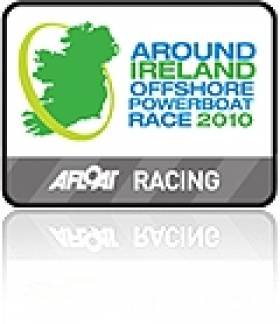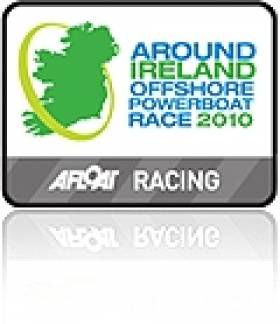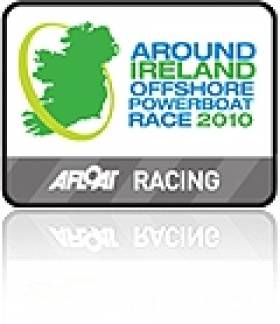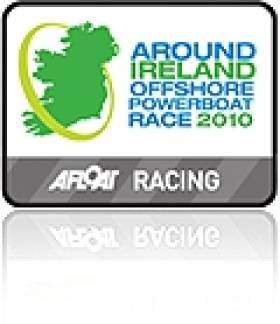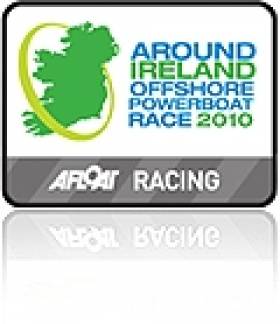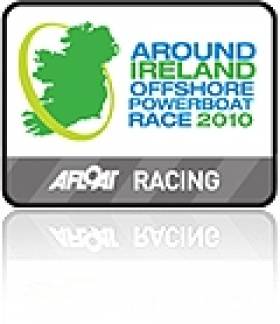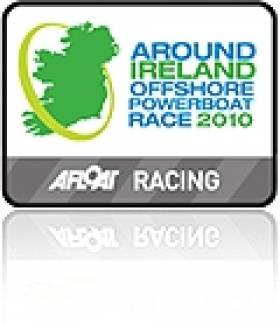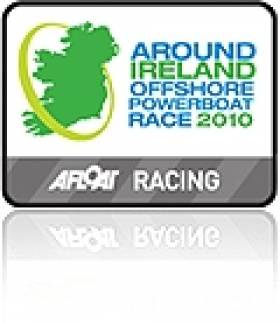Displaying items by tag: Around Ireland Powerboat Race
Around Ireland Race organiser Justin McInerney's Team Pulsar Racing had two boats in this month's inaugural Around Ireland Powerboat Race, a powrboat race that lived up to its billing as a tough one. Reliability and consistency were key components that piad off for Team Pulsar in this powerboat race and resulted in some well-deserved honours.
With two high powered boats entered in the race (Milwaukee Seawolf and Guardian Wolf), Team Pulsar Racing put in a performance over the eight day event, which totalled 800 miles around the beautiful coastline of Ireland.
Milwaukee Seawolf, piloted by Justin Mc Inerney, Chief Executive of Pulsar direct Ltd. and Andrew Varley finished second overall, first in its class. Guardian Wolf, piloted by Derek Stanley and Paul Lewis finished the challenging race in third place overall, and first in the Class D Stock.

“Offshore Powerboat Racing is not for the faint hearted,” commented Justin Mc Inerney, owner of Team Pulsar. “We understand the extremes that our boats come under during these demanding races and therefore have to choose our partners and equipment carefully. This is why we have chosen to stick with proven suppliers who can deliver reliability and durability time after time.”
Team Pulsar Racing has worked closely with several key partners during the many races and record attempts. Choosing the right hull and engine combination might seem logical and relatively easy, however delivering a reliable pairing is a much more complicated matter. Over the years Team Pulsar has chosen to work with the likes of Humber and Suzuki for their racing – delivering impeccable performance and reassuring peace of mind when testing the limits during competitive racing.
“Our boats have to overcome extremely demanding conditions during these marathon races,” exclaims Mc Inerney. “I am completely amazed by the spectacular quality and capability of the Humber Quinquari Offshore Hulls used in both Milwaukee Seawolf (10 metre hull) and Guardian Wolf (8.5 metre hull). Their build quality and sea keeping capabilities combined with over 50 years of RIB building experience gives us hulls we can trust. It is very comforting having a hull you can push to extreme limits knowing that at the end of the race they will be ready for more.”
Team Pulsar Racing has adopted the same attitude to their choice of engines. A pair of Suzuki DF300 outboards powered Milwaukee Seawolf to its impressive finish, with a pair of DF200’s making the difference for Guardian Wolf during the race. Despite the rigorous demands being put on the engines by both the teams and the conditions, not one element faltered.
Mc Inerney states, “As a team, we have done over 8000 miles of racing in the last 24 months. All of it has been at over 5000 revs and the engines have coped amazingly. You can run these engines all day at wide open throttle, as we did for the 19 hours Around Ireland Record in 2009 and when finished they will happily drop back to tick-over as if you had just come back from a leisurely cruise. Other racing specification engines may be faster; however none of them has the same permanent reliability of the Suzuki’s.”
Driving at high speed in just about any sea state requires the best in seat shock mitigation. Again, Team Pulsar has continued its long relationship with world renowned shock mitigation specialists, Shockwave of Canada. Without high quality shock mitigation, racing in challenging conditions over extreme distances is practically impossible.
The Shockwave Offshore Patrol range has been used on Guardian Wolf since 2008 and the team was also one of the first in the world to install Shockwave’s high-tech ICE console onboard Milwaukee Seawolf in 2009.
As a valued partner, Team Pulsar has worked closely with Shockwave on the ICE console and has assisted with several design changes that have enabled Shockwave to further perfect their product. Now used by North American military and navy, the ICE console is amongst the very best technology available on the market today.
During these treacherous, long distance powerboat races, even the best engines and strongest hulls are useless if a team gets lost. Navigation and marine electronics are vital components in offshore racing and something that Team Pulsar takes very seriously, that is why the team has established a long standing relationship with one of the industry’s most dynamic and reliable manufacturers of marine electronics, Raymarine.
“We were appointed Raymarine Ambassadors in 2010 and have continued to work with Raymarine on our boat electronics,” says Mc Inerney. “We look for a combination of great design, ease of use and integration, and of course the ability to withstand extreme conditions. We employ state of the art electronics on both boats using two of the latest Raymarine E120w screens on Milwaukee Seawolf and the new Raymarine C140w screens on Guardian Wolf. The amount of information required when racing is very high and you need to be able to capture this at speed. The screens allow for this and can provide just about any data you need at a glance.”
Building and racing high speed RIB’s that can take the pace and keep on coming back for more is all about quality and build. John Price and the team at Quinquari Marine have developed an enviable reputation for high quality boat building. Specialising in large offshore Humber hulls, John works closely with Humber building commercial specified RIB’s for markets all over the world. This team of specialists are the final piece of the racing preparation jigsaw and continue to deliver excellence time and again.
Team Pulsar Racing will be competing at Cowes Torquay Cowes and other powerboat races throughout the year. Plans are already being made for the next Around Ireland Offshore Powerboat Race in 2014.
Powerboat Racers Prepare for Fenit Leg
The boats competing in the Around Ireland Powerboat Race roared into Waterford yesterday and will take a day off to prepare for the leg to Fenit on Friday morning.
The weather down the Irish sea from Bangor was described as ‘a little lumpy' and all crews had to work quite hard at their motoring and steering. However, all boats arrived safely except for Newstalk Galway Girl, which had to stop in Dun Laoghaire for repairs to reoccurring fault. Dreamer was also forced to retire from the race due but is expected to be on the start line on Friday for Leg 4 from Waterford to Fenit..
1st - Cinzano Bianco - 13h48
Time taken: 4 hours, 44 minutes, 16 seconds.
Average speed 44.32 Knots
2nd - Sea Wolf - Team Pulsar - 14h53
Time taken: 5 hours, 49 minutes, 49 seconds.
Average speed 36.02 Knots
3rd - Wolf - Team Pulsar - 14h54
Time taken: 5 hours, 50 minutes, 17 seconds.
Average speed: 34.97 Knots
4th - Zoolander Blue Steel Racing - 16h15
Time Taken: 7 hours, 11 minutes, 28 seconds.
Average speed 29.20 Knots
The boats will arrive in Fenit as part of the Fenit Seabreeze festival and race to Galway on the final leg on
Local Galway Flyer was forced to retire from the second leg of the race due to an electrical failure yesterday but after a tow in to Bangor the high speed powerboat started the third leg from Bangor to Waterford this morning but this afternoon the race tracker shows Enda O'Coineen's entry has pulled into Dun Laoghaire as the fleet leader arrived in Waterford.
First into Waterford is Cinzano Bianco after a 220-mile completed in approximately 5 to 6 hours. Race results so far below:
Leg 1 Race results: Galway to Killybegs - 174 miles1st Cinzano Bianco: Time taken: 4 hours, 11 minutes, 38 seconds. Average speed 39.35Knots
2nd Sea Wolf: Time taken: 5 hours, 4 minutes, 26 seconds. Average speed 32.35Knots 3rd Wolf: Time taken: 5 hours, 27 minutes, 42 seconds. Average speed 30.21KnotsLeg 2 Race results: Killybegs to Bangor - 176 miles
Leg 2 Killybegs to Bangor: 1st Cinzano Bianco at 13h10. Elapsed time: 3 hours, 48 minutes, 05 seconds. Average speed 43.41Knots2nd Sea Wolf at 13h53. Elapsed time: 4 hours, 31 minutes, 30 seconds. Average speed 36.46 Knots3rd Wolf at 13h58. Elapsed time: 4 hours, 35 minutes, 59 seconds. Average speed 35.87 Knots4th Zoolander at 15h14. Elapsed time: 5 hours, 52 minutes, 40 seconds. Average speed 28.07 Knots
Heights of Abraham Storms to Galway Powerboat Success
Heights of Abraham completed a clean sweep at the Galway Grand Prix of the Sea on Monday after another imperious display of offshore powerboat racing secured back-to-back titles for the Matlock-based team.
A combination of aggressive handling and punishing throttle power from Rupert Pugh as well as accurate positioning from Dan Whapples earned the 300 Class frontrunners a sixth successive race win of the season.
Leading from the front for the entire weekend, Messrs Pugh and Whapples displayed outstanding poise around the corners, which subsequently gave their rivals little chance of stealing the gold.
Heights of Abraham command a 25-point lead in the series after two rounds and Pugh is delighted with the team’s rich vein of form. He said: “It’s been an unbelievable start to the season. To win six-out-of-six races is fantastic and an excellent reward for a great team effort.”
Maurice Lacroix claimed the runners-up spot ahead of Evans Heritage Developments by virtue of its superior race-by-race results percentage. Michael and Stephen Baggs from Maurice Lacroix continue to be the best of the rest in the 300 Class but signs during the Galway event suggest that Rough Cut Racing and Shark are not too far behind this weekend’s top three whilst the Fuel Girls improve after every new lap.
Racing in front of crowds in excess of 90,000 as part of the eight-day Galway Powerboat Festival, Pugh was quick to pay tribute to the fantastic support for the nautical extravaganza. He said: “It’s been a fantastic advert for powerboating. All of the pilots have been really impressed by the huge spectator interest and we hope to be back at this wonderful centre of maritime excellence again next year.”
The 150 Class unfolded in a similar fashion with Premier Cru powering its way to consecutive Grand Prix of the Sea triumphs. Having brutally beaten its rivals into submission over the weekend, pilots John Wilson and Neil Scarborough suffered their first hiccup of the season when Eclipse pair Rose Lores and Sara Cureton upset the formbook by stealing first place in Monday’s penultimate race.
Undoubtedly Monday’s solitary loss was the most exciting race of the three-day bank holiday feast of marine motorsport and the enthralling sight of Premier Cru hunting down the ladies from their slipstream for the entire duration of race three will give the other contenders plenty to mull over until July’s next event in Pwllheli, Wales.
Neil Scarborough of Premier Cru hailed Lores’ drive as probably the ‘best of her life’ and lavished praise on Cureton’s coolness under pressure. He said: “The ladies were outstanding. It was a really frustrating race but they didn’t make one mistake.
“We’ve had a fantastic Grand Prix. It’s testament to the team’s ambition that we were fairly disappointed to finish second in race three but that’s the standard we are setting for ourselves.”
The pace of Eclipse the performance of debutants Flying Sparks and Octane were unquestionable highlights of the successful maritime festival that saw Powerboat P1 establish an tremendous footing in Ireland at the conclusion of its first-ever visit to the Emerald Isle.
Monday 150 Class Results:
1. Eclipse
2. Premier Cru
3. Team Fox
4. Flying Sparks
5. Octane
6. GSS Mermaid
Monday 300 Class Race Results
1. Heights of Abraham
2. Maurice Lacroix
3. Evans Heritage Developments
4. Rough Cut Racing
5. Fuel Girls
Team Shark (DNS)
Galway Grand Prix of the Sea Overall Results
150 Class
1. Premier Cru
2. Eclipse
3. Team Fox
4. Flying Sparks
5. GSS Mermaid
6. Octane
300 Class
1. Heights of Abraham
2. Maurice Lacroix
3. Evans Heritage Developments
4. Rough Cut Racing
5. Fuel Girls
6. Team Shark
Here is the tracker link to follow the Around Ireland Powerboat Challenge. Click here. The boats are now in Killybegs after the first leg of the five day voyage from Galway.
The green flag went up at 0900 on a grey bank holiday Monday for 5 of the 6 entries in the Around Ireland Powerboat Race.
The local team Kilcullen Galway Flyer driven by Tom Montgomery Swan and navigated by Enda O’Coineen powered off the start line at around 80 knots whilst the other boats revved up to around 50 knots.
Unfortunately Team Dreamer driven by Kerryman Philip Fitzgibbon did not make it to the start of the Race in Galway due to technical difficulties but hope to be on the start line in Killybegs tomorrow morning (Tuesday 08 June 2010).Commenting at the start of the race,
Denis Dillon, Powerboat Development Officer, Irish Sailing Association stated that ‘There is a huge history of powerboating in Ireland in fact the first ever International powerboat Championship for the Harmsworth Trophy was held in Cork in 1903.
Around Ireland Powerboat Race 2010 is in its inaugural year and organisers are hoping that it will become a permanent fixture on the international circuit and will grow to a major sporting event.’The race will circumnavigate the entire coast of Ireland and will be the toughest endurance powerboat race on the International circuit. The 5 days of racing will be a true test of man and machine and there will be 5 stages with events at each of the stopovers:
Galway to Killybegs (07 June)Killybegs to Belfast (08 June) Belfast to Waterford (09-10 June)Waterford to Fenit (11 June) Fenit Sea Breeze Festival will run Friday 11- Sunday 13 JuneFenit to Galway (12 June) The fleet is expected back in Galway on Saturday 12 June meanwhile the festival which saw crowds of over 90,000 flock to Galway over the weekend will continue daily from 1000 to 1030 daily.
For the finale on 12 June, prepare to be amazed and in awe at the P750 Cross Border Powerboat Championship and make sure you are at the dock to welcome back the winner of the Around Ireland Powerboat Challenge on Saturday 12 June. (1400 approximately)
AROUND IRELAND ENTRANTS
Cinzano Bianco
Driver: Markus Hendicks Crew: Tim Grimshaw and Eric Smilie
Engines: 850 X 2 ·
Kilcullen Galway Flyer
Driver: Tom Montgomery-Swan Navigator: Enda OCoineen
Hull Fabio Buzzi Rib
CC 6000
Length 11.00
Engines Mercury 300x Pro Max x2 ·
Seawolf – Team Pulsar Racing
Driver: Justin McInerneyCo Pilot: Andrew Varley
Hull Humber Quinquari Rib
Length 10.00
Engines Twin Suzuki SDF300 Engines ·
Dreamer
Driver: Philip Fitzgibbon
Co-Pilot: James ThompsonTwin Suzuki SDF300
Excalibur Rib ·
Wolf Team Pulsar Racing
Driver: Derek StanleyCo-Pilot: Paul Lewis
Hull Humber Quinquari Rib
Length 8.50
Engines Twin Suzuki DF200 Engines ·
Zoolander Blue Steel Racing
Owner Driver: Oisin Ryan
Co-Driver: John RyanCo-Driver/
Navigator: Gareth Tolan
Length 8.00
Engines Twin Honda 255 with Zodiac
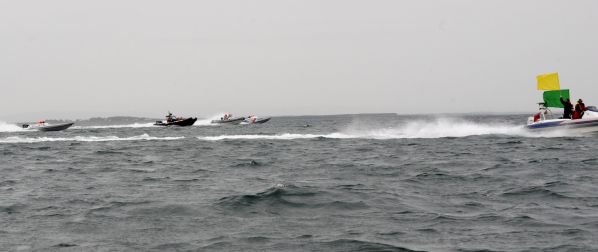
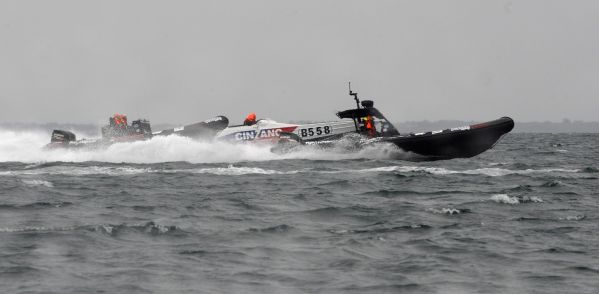
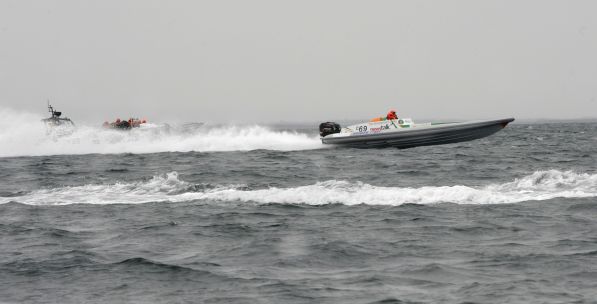
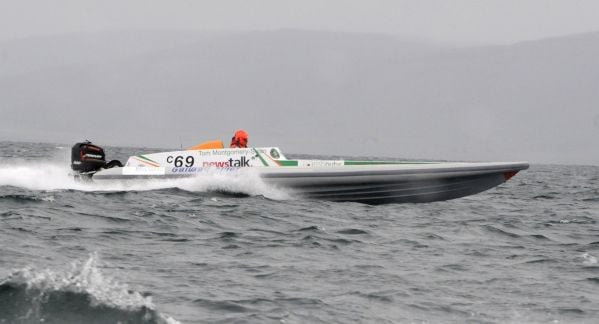

The first Round Ireland Offshore Powerboat Race was scheduled to depart Galway City today at 9am. It is far from the much hoped for fleet of 50 boats but the six competitors will nevertheless jet off on a five day-long adventure around the country, making stops in Killybegs, Bangor, Waterford and Fenit, before returning to Galway's finish line on Saturday 12th June. The forecast for the first leg is for southeast winds of force 4 to 5, becoming cyclonic variable force 2 to 4 this evening. There will be occasional rain with drizzle and mist. Met Eirean say visibility is moderate to poor The organisers have set up a tracker to keep up to date with the position of the boats during the race but by 10am it showed the boats were still in Galway harbour. The leaderboard showed the following: Cinzano Bianco, Kilcullen Galway Flyer, Seawolf - Team Pulsar Racing, Dreamer, Zoolander - Blue Steel Racing, Wolf - Team Pulsar Racing. Click here.
Abraham in Command of Galway Speedboats
Heights of Abraham has one hand on the overall Galway Grand Prix of the Sea trophy after another ruthless performance on Sunday tightened the Matlock team’s grip on the Powerboat P1 SuperStock Championship 300 Class prize in Ireland.
The imperious pair of Rupert Pugh and Dan Whapples dished out another lesson in offshore powerboat racing after the dynamic duo romped home by over ten seconds in Salthill.
Leading from the front, Messrs Pugh and Whapples gave their rivals little chance of stealing the gold with some outstanding cornering in testing conditions.
Now looking very difficult to beat after its fifth successive win of the season, HeightsofAbraham pilot Pugh is confident of completing another clean sweep in Galway this weekend. He said: “It’s been an unbelievable couple of races. Our reliability has been a key ingredient of our success so far this season and if we can hold it together in some tricky conditions forecast for Monday then I’m sure we’ll finish the job off.”
Galway was painted in glorious golden sunshine in the afternoon and although the slight choppiness on the water coming off the stunning Salthill shoreline made it far from a comfortable day’s work, Pugh was quick to pay tribute to the fantastic support, which saw numbers reach a monumental 90,000 between the Galway Harbour and Salthill race villages over the weekend. He said: “It’s been a fantastic weekend for the sport. All of the pilots have noticed the huge interest from the spectators and we are all looking forward to completing a great Grand Prix of the Sea and hopefully coming back again next year.”
Once again continuing yesterday’s formbook, Premier Cru stole the headlines in the 150 Class. Powering home by a considerable margin, John Wilson and Neil Scarborough found an extra-gear to keep up their unbeaten record in the 21 ft discipline this year.
Taking the checkered flag ahead of Eclipse and Team Fox, Premier Cru pilot John Wilson pinpointed the “immense” navigation of Neil Scarborough as the chief reason for Sunday’s race victory. He said: “Neil is a fantastic navigator. He allows me to focus purely on what’s in front of me. We have a massive amount of respect for each other and our experience in the boat together is reaping great rewards this year.
“We were in the mid-52’s (mph) for the entire 10-laps and Flying Sparks were hitting 53 mph so the competition is starting to hot up.
“In smooth conditions on Saturday the lighter power-to-weight ratio suited the girls in Eclipse but today the rougher conditions were perfect for us.
ENDS
Whapples Stirves for Greater at Galway Powerboat
HeightsofAbraham were the toast of Galway on Saturday evening after the 300 Class speedsters conquered Salthill to score a fourth successive SuperStock Championship win of the season.
Matlock’s finest, Rupert Pugh, and Warsash wizard, Dan Whapples, bolstered their chances of claiming back-to-back Grand Prix of the Sea trophies with yet another flawless performance on the water.
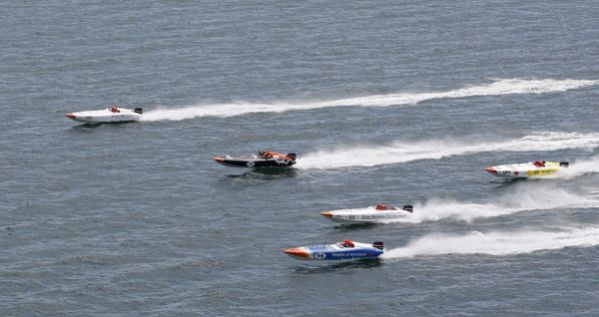
The team’s unrivalled speed and poise around the turns now makes them favourites to secure a record-breaking weekend. After standing head and shoulders above runners-up Evans Heritage Developments and Rough Cut Racing on the podium, navigator Whapples was confident of even more glory on Sunday. He said: “We’re really pleased with the win today. Galway is an outstanding venue and it was fantastic to race in front of large crowds and interact with the spectators afterwards.
“Today’s victory was down to a fantastic combination of having a great boat setup and getting a quick understanding of the conditions. We’ve prepared really well in training and it’s now showing.”
Having had more time getting used to this season’s new Mercury 300 XS Engines, Whapples believes the competition will get feistier after every race. “Evans Heritage Developments were a lot stronger with Rhys Evans at the wheel today. There is some great potential in the whole fleet and just observing how close Rough Cut Racing and Team Shark were battling it out towards the end shows that once everyone finds their rhythm, it’s going to be almighty close.”
Galway Powerboat Timetable Here
Saturday 05 June Day 1 P1 Superstock Grand Prix of Galway
The P1 Superstock Championship will see some of the UK's biggest thrill seekers tackling the challenging elements of the Atlantic Ocean. Consisting of two race classes, 150 and 300, 14 P1 powerboats will entertain locals, tourists and motor sport fans alike, as they enter into high-stakes speed racing on Galway Bay. Each boat has exactly the same manufactured hull and identical engines, which means that the onus is placed firmly on the skills and nerve of the driver and navigator. Live commentary in Salthill.
1030: Practice Race
1330 and 1415: Race Start 150 Class
1430 and 1515: Race Start 300 Class
1700: Podium prizegiving in the Race Village
Sunday 06 June Day 2 P1 Superstock Grand Prix of Galway
Live commentary in Salthill
1030: Practice Race
1330 and 1415: Race Start 150 Class
1430 and 1515: Race Start 300 Class
1700: Podium prizegiving in the Race Village
Monday 07 June Start of the Around Ireland Powerboat Race and Day 3 P1 Superstock Grand Prix of Galway
The Around Ireland Offshore Powerboat Race requires offshore navigation capabilities combined with rock solid reliability to ensure success. The mix of physical rigour with technical performance is what attracts most people to the event. The ability to endure in an extreme environment is what offshore racing is all about.
0900 Start of the Around Ireland Powerboat Race.
1130 and 1215: Race Start 150 Class (P1 Superstock)
1230 and 1315: Race Start 300 Class (P1 Superstock)
1430 Final podium prizegiving for the P1 Superstock Grand Prix of Galway in the Race Village
Around Ireland Powerboat Race overnights in Killybegs (local festival)
Tuesday 08 June
Galway Powerboat Festival continues in the Race Village 1000 – 1030
Stage 2 of Around Ireland Powerboat Race Killybegs to Belfast. Overnight in Belfast
Wednesday 09 June
Galway Powerboat Festival continues in the Race Village 1000 – 1030
Stage 3 of Around Ireland Powerboat Race Belfast to Waterford. Overnight in Waterford
Thursday 10 June
Galway Powerboat Festival continues in the Race Village 1000 – 1030
Around Ireland Powerboat Race: Layday Waterford. Overnight Waterford
Friday 11 June
Galway Powerboat Festival continues in the Race Village 1000 – 1030
Stage 4 of the Around Ireland Powerboat Race Waterford to Fenit (Overnight Fenit at the Fenit Sea Breeze Festival)
Saturday 12 June P750 Cross border Championships and finish of the Around Ireland Powerboat Race
Galway Powerboat Festival continues in the Race Village 1000 – 1030
1000 Round 1 of the P750 Powerboat Championship
1400 Finish of the Around Ireland Powerboat Race and prizegiving in the Race Village
Jet Ski activity on the bay all day





























